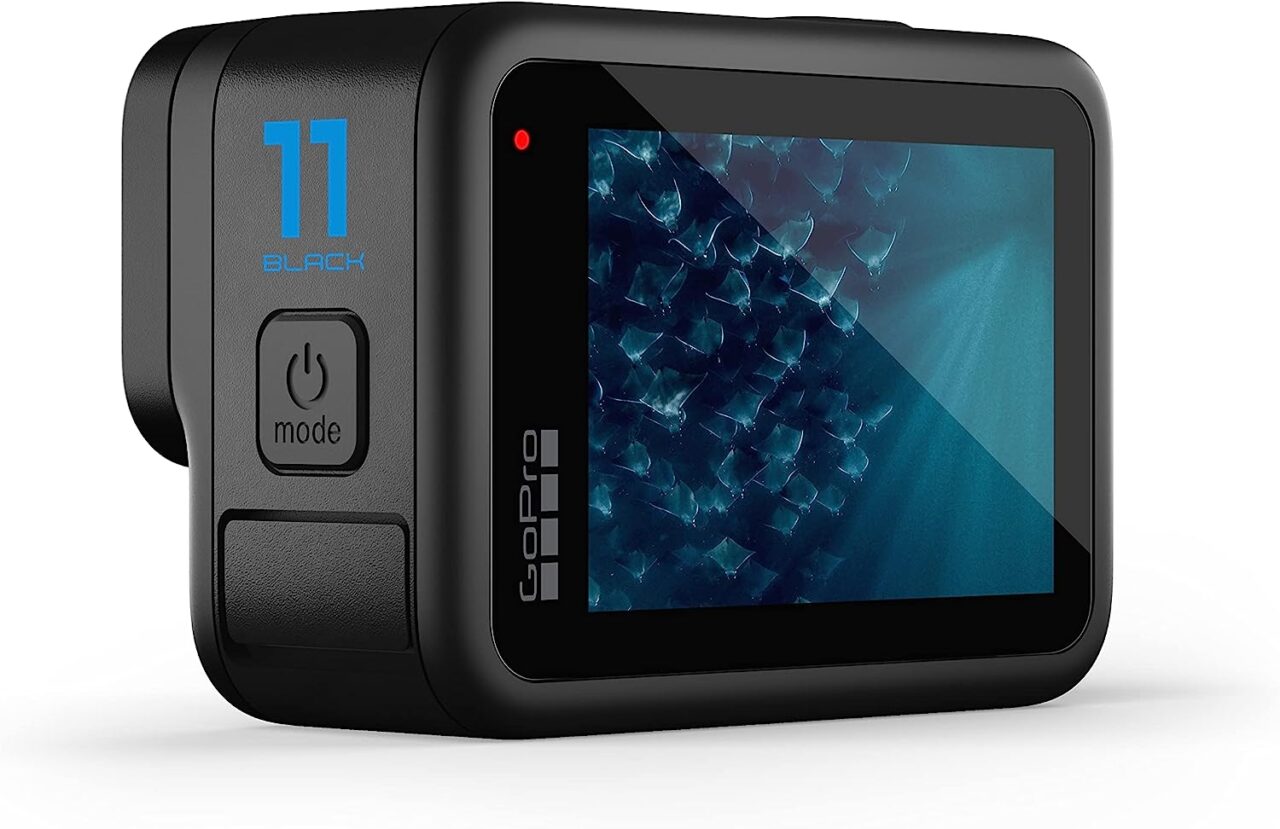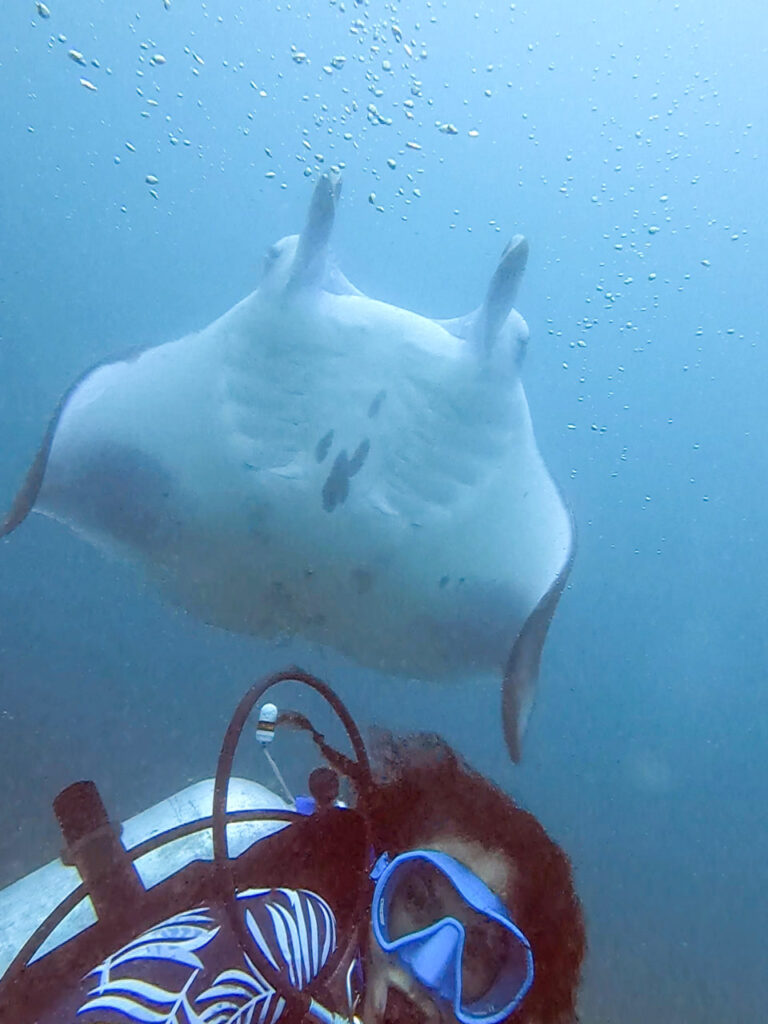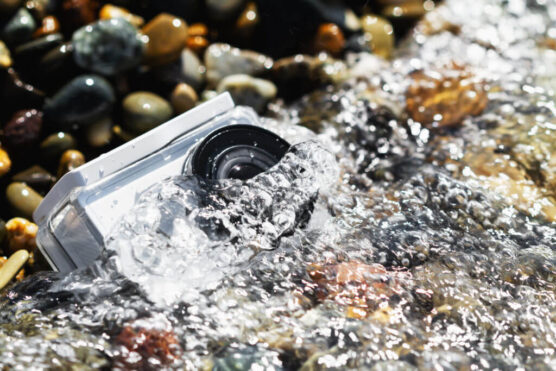
An underwater action camera is a small digital camera that can be placed in waterproof casing and then taken underwater – they’re highly popular among divers and other water-sports enthusiasts.
But not all underwater action cams are equal! Some capture better quality videos and photos than others or have more underwater-friendly features.
Time to dive into our brutally honest reviews of the 5 best underwater action cameras of 2025!
We’ve written these reviews based off our own experiences using underwater action cameras to create content for Diving Squad.
Key factors such as depth rating, video definition, photo quality, video stabilization and price have all been taken into account. Let’s do this!
QUICK ANSWER:
- Top Seller: Akaso V50 Elite
- Best Underwater Action Camera: GoPro Hero 11
- Great Value Akaso EK7000
- Cheapest: Dragon Touch
- Most Beginner-Friendly: DJI Osmo
REVIEWS:
1) Top Pick: GoPro Hero 11
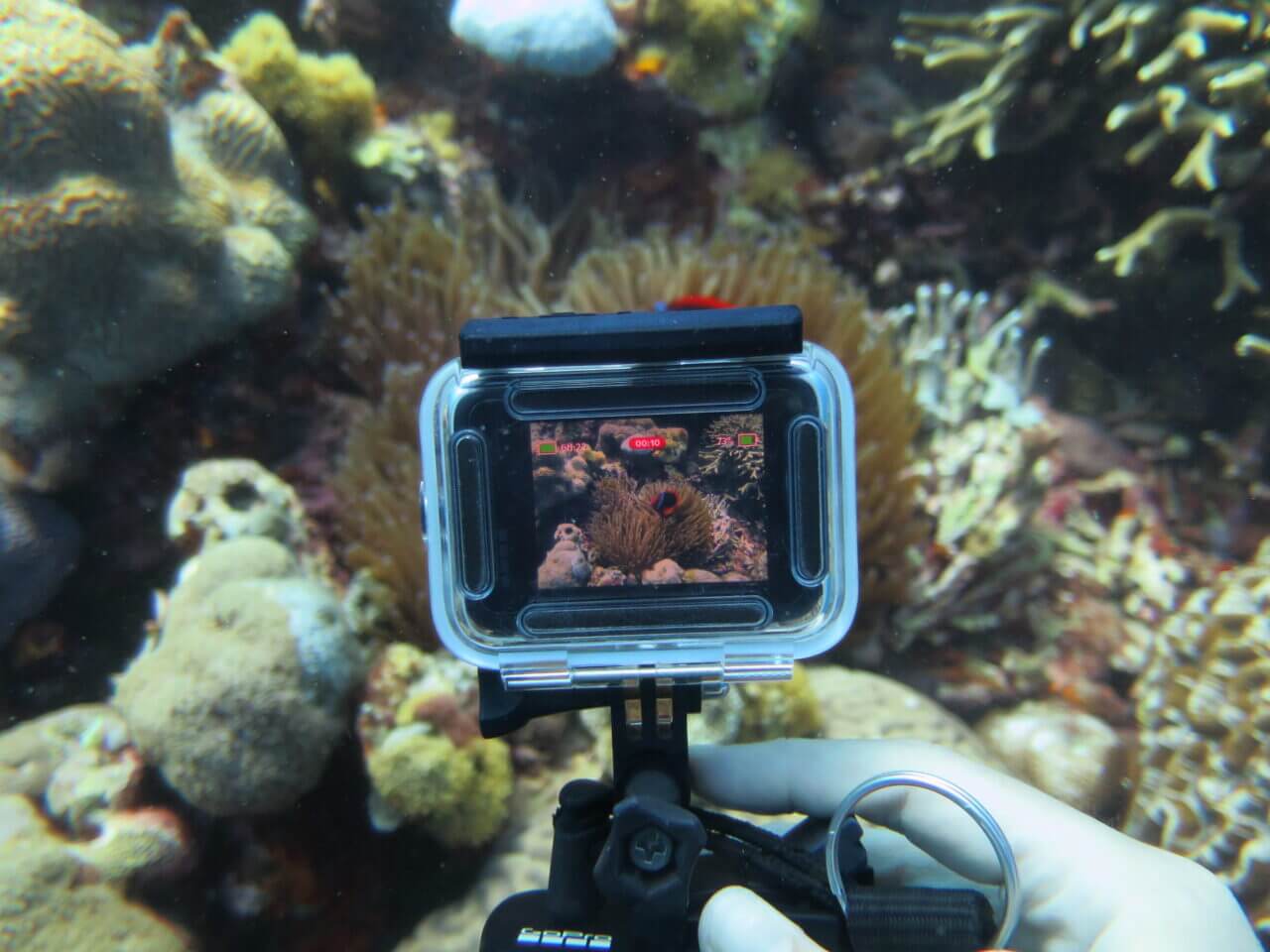
It might be more expensive – but without a doubt, the GoPro Hero 11 has the best video and photo capabilities, the smoothest video stabilization tech – and the most adjustable features!
Currently, it is the only underwater action camera that can record in 5.3K/60fps video and snap 27mp photos!
It features GoPro’s latest video stabilization technology: “hyper smooth blast 5.0” which is superior to all other underwater cameras stabilization tech, resulting in exceptionally smooth video clips.
You can adjust the white balance and ISO settings above water and store these setups as custom presets that can be accessed underwater – allowing for awesome underwater colour correction.
Straight out the box, it is waterproof to 10m / 30 ft. However, it can be taken all the way down to 60m / 200ft when placed within it’s separately purchased underwater housing.
There’s also a range of other great accessories that can be seperately purchased including a mounting tray, underwater lighting, macro lenses and filters.
PROS:
- Shoots 5.3K video (60 frame rates) = excellent image quality in videos
- Superb video stabilisation
- Adjustable white balancing and ISO
- Huge 27 MP image sensor = good quality images
- Massive battery life
- Distortion calibration.
CONS:
- Waterproof casing sold separately (but not expensive!)
2) Best Seller: Akaso V50 Elite
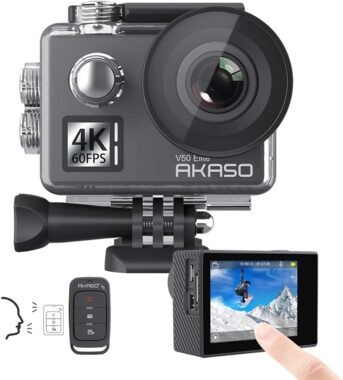
Akaso are an extremely popular manufacturer of affordable yet high performing action cameras that include underwater housing in their main price.
There’s a whole range of different Akaso cameras available, but our favourite model is the Akaso V50 Elite as it offers the best overall quality.
The Akaso V50 Elite shoots full HD 4K video at up to an impressive 60 frame rates and has three view angles as well as integrated video stabilization technology to counter shaky hands.
It can take crisp 20mp photos and also features an 8 x digital zoom as well as WiFI integration, making it extremely easy to share photos and videos on social media with.
Burst photo, loop recording and time lapse modes are all available.
The battery life is pretty decent at around 60 – 90 minutes (depending on video resolution), although not as long as that of the Hero 9.
A big plus of the V50 Elite is that it’s underwater housing is included in the already very reasonable price and with this it can go to 131 ft / 40m underwater – which is the depth limit for recreational diving.
Rugged and compact, the Akaso V50 Elite is more than just an action camera for underwater. It’s voice control feature, remote control, wrist strap and helmet accessories make it superb for recording land missions to!
PROS:
- Good quality images.
- Affordable.
- Underwater Housing included.
- High quality video stabilization.
- Burst Photo / Loop Recording / Time Lapse modes.
- Plenty of extra accessories for land use.
- 20 MP image sensor – crisp and clear photos.
- Fairly long battery life.
3) Great Value: Akaso EK7000
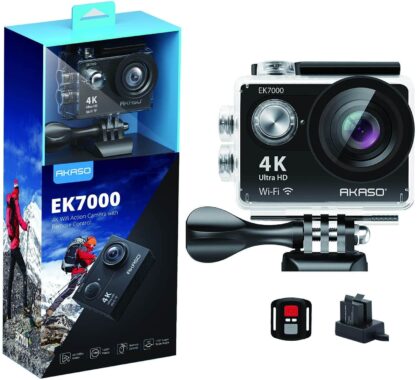
Despite being so cheap, the Akaso EK7000 packs a serious punch. It can record underwater video at up to 4K/30fps and take 16mp resolution for crisp and detailed images.
There is the option for manual white balance adjustment and it also features decent electronic video stabilization.
With it’s included underwater housing the Akaso EK7000 is waterproof to 98ft / 30m, which is deeper than most recreational scuba dives go.
If you’re on a tight budget but you want to try out underwater photography and videography for the first time, the Akaso EK7000 is the cheapest and also best value for money option out there.
(We have a main page on the best budget underwater cameras)
PROS:
- Cheap.
- Easy to use.
- Waterproof housing included.
- Video Stabilization.
- Decent battery life.
- Plenty of settings and features.
- 20 Mp sensor = detailed photos.
- Cheapest of the best action cameras.
CONS:
- Videos can be a little noisy.
- Photos snapped past 10 meters may have some colour distortion.
4) Cheapest: Dragon Touch Action Cam
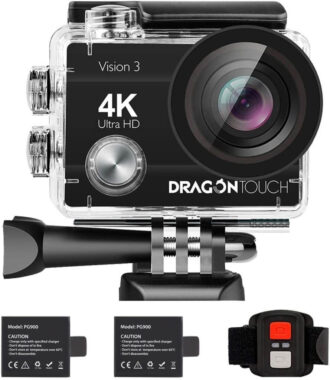
The Dragon Touch is the cheapest underwater action camera on our list.
For the most part, its very similar to the Akaso EK7000. Both shoot up to 4K 30fps and both can go to 100ft / 30m in their underwater housing.
The only measurable difference between them is that whereas the Akaso EK7000 has a 12mp sensor, the Dragon Touch sensor is 16 mp, which may result in slightly crisper images under some lighting conditions.
However for the most part, both cameras are identical in their capabilities and most users will struggle to tell the difference between videos and photos shot by the Dragon Touch vs the Akaso EK7000.
But for only $60 more, you can buy a much better underwater action camera: The Akaso Elite V50; which is still our number one cheap underwater cam choice. Read about the Akaso V50 here!
Ok, we’ve described the cheapest underwater cameras available; action cameras with underwater housing. Next, we’ll be reviewing slightly more expensive cameras that’ve been designed specifically for underwater use.
PROS:
- Second cheapest option.
- Can go to 100ft / 30m.
- Great video capabilities at 4k 30fps.
- 16mp sensor.
CONS:
- No electronic image stabilisation.
- Can’t shoot 4k at 60 fps.
.. these are resolved by the Akaso V50 Elite!
5) Easiest to Use: DJI Osmo
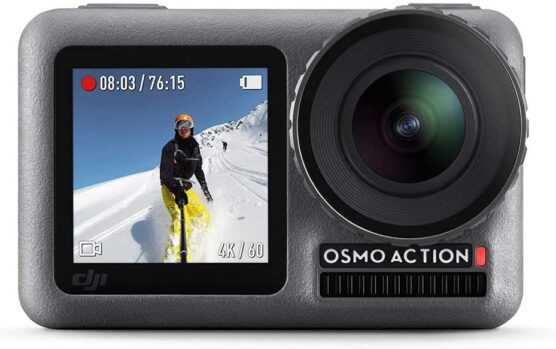
DJI are well known for making superb drones and gimble devices, but in more recent times they’ve branched out to include action cameras in their repertoire.
Straight off the bat, the DJI Osmo is the only action camera we’ve reviewed that features three buttons as a posse to just one or two. This makes controls that little bit faster to scroll through.
The custom mode let’s you store, list and select frequently used shooting modes and settings for ease of use. There is also a quick switch button for rapidly swapping between modes and settings.
Combine this with an intuitive user interface – as well as two large lcd display screens (one which is front facing, for selfie framing and the other at the back) and the DJI Osmo is a great action cam for beginners.
It’s capable of shooting 4K video at up to 60fps and has a 12 MP sensor for snapping crisp, clear photos.
Other features include super slow mo, “RockSteady” EIS anti-shake technology and three aspherical layers of the lens, which effectively reduce lens glare and distortion to deliver crystal clear images.
Battery life is fairly decent at around 60 minutes when shooting 4K video and longer at lower video resolutions.
The DJI Osmo Action camera is waterproof to 36ft / 11m straight out of the box and when placed in the separately purchased but cheap, Sruim underwater housing, it can go to 200 ft / 61m.
This is an excellent underwater action camera for first time diving photographers and videographers – it maintains high quality whilst being the most straightforward action camera to use.
PROS:
- Affordable.
- 3 Buttons (other action cams only have 1 or 2).
- Custom Mode to select favourite shooting modes & settings.
- Quick Switch button.
- Easy to use.
- Decent battery life.
- EIS anti-shake tech.
- Good low light performance.
- 3 layers to lens for reducing glare and distortion.
CONS:
- Image sensor is 12MP which is a little smaller than other options – meaning photos won’t be as detailed.
- No zoom.
- UW Housing must be bought separately, however it is very affordable!
Underwater Action Cameras INFO & TERMINOLOGY
What is an Action Camera?
An action cam is a digital camera that’s been designed especially to record action whilst being immersed in it. What counts as action? It’s usually sports and adventure activities such as surfing, biking, skiing – and scuba diving!
Action cams are typically worn or mounted in a way that they can shoot from the point of view of the shooter. They tend to be durable, rugged and waterproof at surface level.
They’re usually low to mid price as a posse to more expensive cams and a lot easier to travel with due to their small size.
Common features include being able to record in 4k video, video stabilization, burst and time lapse modes, slow mo and the use of CMOS image sensors.
Generally speaking action cameras are best used for shooting video – they produce better footage than photos due to having fairly small image sensors, although can still snap some decent stills!
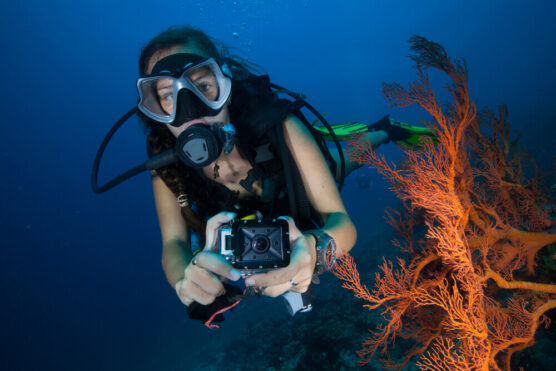
So what’s an Underwater Action Cam?
Whereas most action cameras tend to be waterproof to around 10 m / 33ft, they can be taken much deeper underwater if placed in underwater housing – just be sure to purchase the right uw casing for the right cam!
Underwater housing is either included in the main price of an action cam or has to be purchased separately but usually costs less than twenty bucks.
So when we’re talking about underwater action cameras, we’re describing regular action cams for which underwater housing is available, that allows them to be taken at least as deep as recreational diving limits.
Within their waterproof casing they make excellent cheap dive cams, but can still be used for all the land based activities you’d expect of a regular action cam.
Although many action cams primary source of control is via the touchscreen display, when placed in their waterproof casing, they can only be operated via buttons.

Terminology & Specs:
Video Resolution
This refers to the number of pixels displayed on the screen. More pixels means a higher image resolution which results in more detailed image quality.
Levels of video resolution are usually described according to the width of how many pixels can be fit within each dimension. For example, with 1080p video resolution, there are 1080 pixels in the width of the dimension. 1080p is a higher resolution (more pixels) and therefore provides better video than 780p. However, it’s not as high as 4K!
Recording in higher video resolution produces better video footage but uses more battery.
4K Video
4K video refers to a video resolution that has 4000 worth of pixel width within the image. It results in much clearer, more detailed video footage than the next video resolution down: 1080p. These days, all decent cams are expected to have 4K capabilities.
If a camera can’t shoot 4K video, don’t bother with it – it’ll be terribly outdated compared to newer models! You’ll be relieved to know that because we only review the best gear, all the action cams on this page can shoot in 4K video.
5K is going to be the next big thing in terms of video resolution as it provides even more detail than 4K. But currently, only the GoPro Hero 9 offers 5K video resolution!
(We’ve written an entire article specifically on underwater video cams!).
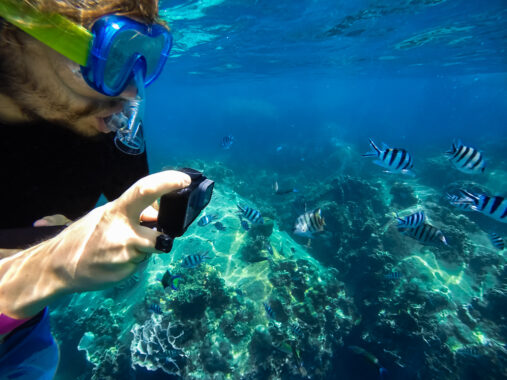
FPS (frames per second)
FPS stands for frames per second or frame rates and it refers to how many video frames a camera can capture per second. The higher the fp the higher the quality of video footage. So if a camera’s max video capability is 4K at 60fps, this is better than 4K at 30fps – simple as!
Video Stabilization
This refers to gyro, EIS, algorithm or other technology installed in a camera, which is able to counter for and correct shaky video footage.
Not all video stabilzation is equal – the GoPro Hero 9 has some of the best video stabilization we’ve seen yet. That said, even the best video stabilisation is not a magic bullet for terrible camera skills.
If, for example, you were to manically wave your camera about in every direction as though it were some sort of mallet – stopping only to use it to smash in to a rock or the face of a passing fish, your video footage would still come out horrendously shaky and unwatchable, vid stabilisation tech or not. You might also get fish blood on the lens.
However, if say, you were filming a drift dive and the current had been knocking you about this way and that; so long as you’re putting in some effort to keep the cam steady, the video stabilization tech will do the other half of the job for you and you can get some footage that looks extremely smooth even if it felt anything but, at the time you were shooting it!
We’ve only reviewed action cam options that have some form of video stabilization.
MP Sensor
A megapixel (mp) is a million pixels – the term not only used for the number of pixels in an image but also for the number of image sensor elements.
The more megapixels a camera has in it’s mp sensor, the more detail it can capture in an image. So a 16 mp sensor can take a more detailed photo than a 12 mp one.
However, whilst a high mp sensor does mean better photo quality, it can actually detract from video recording quality due to making footage more noisy.
Therefore, an underwater camera that is good for both photos and videos, should have a decent number of – but not too many megapixels. A 16 to 20 mp image sensor will be ideal.
The action cameras with the biggest mp sensors are the GoPro Hero 9 and the Akaso Elite V50. All have a mp sensor of at least 20mp, whereas the other 3 action cams we’ve reviewed only have mp sensors of 12!
User Interface
Refers to the overall feel and simplicity of navigating through a cameras menu when selecting modes, settings and viewing photos and videos.
Underwater Housing
Also known as dive housing, it’s the protective outer casing that cameras must be placed in to make them waterproof. Without a case, most action cams can go to 33ft / 10m; but when placed inside underwater casing they can go much, much deeper.
Underwater housing is sometimes included with an action cam but other times it has to be purchased separately but it’s always very cheap.
One thing to bare in mind that most action cams are designed to be operated via a touch screen. However, within their underwater casing they can only be controlled via buttons – which can slow up controls a little, but not too much!
Digital Zoom
Not all action cams have a zoom, but when they do it’s always a digital zoom. This can be a handy feature, but don’t go expecting any extra detail when you zoom in on things, because you won’t get it. Digital zoom is simply a glorified crop – unlike optical zoom which does provide more detail, but is not featured on action cams.
Time Lapse Mode
A video recording mode that captures video at an extremely low frame rate – roughly one or two frame rates per second. When played back, time-lapse video is like the opposite of slow motion.
For example, imagine a video clip of the sun rapidly rising in the sky as the clouds roll past as fast as cars. In the clip, it takes just twenty seconds for the sun to track from east to west before it dips back below the horizon and the sky darkens to night again.
Obviously the scene has been sped up (with time lapse mode) but none of the footage appears shaky or rushed to indicate this. Instead, it looks like everything is happening in real time and that the sun naturally moves that quickly across the sky. This is the effect that time lapse mode gives.
Admittedly, time lapses are less useful for divers as you have a limited amount of time underwater and most time lapse mode effects require you to film the exact same thing for a long time. But it’s still a handy feature to have! You never know when you might want to use time lapse mode on a lobster shedding it’s skin or a hatching shark pup.
Burst Mode
Also known as continuous shooting mode, this is where several photos are captured in rapid succession – something that is particularly good for a subject that is in successive motion. You can then select the best image of the group.
Slow Mo
Allows you to record a video and play it up slower than normal. 4 x slow mo, means you play a recorded piece of video four times slower than normal – 8 x slow means eight times slow – and super slow mo means you can play back the footage 32 times slower than normal.
Extra Tip:
If you’re new to the exciting world of underwater videography/photography, check out our main page on “Underwater Photography Tips for Beginners“. There’s a few simple rules that if you follow, will help you instantly up your underwater recording game.
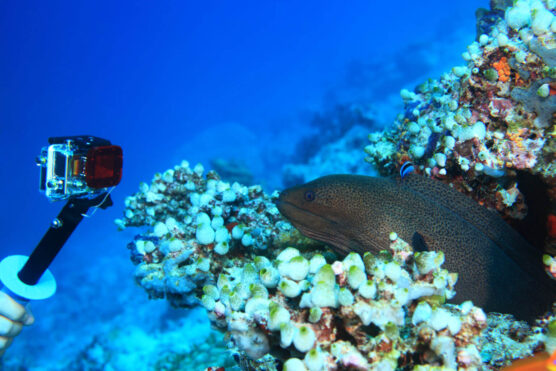
Diving Squad Debriefing
Boom! Article done. We truly hope you’ve found this to be a useful read and that you’re feeling ready to get out there and purchase your dream underwater action camera.
You can rest assured that we constantly scour the markets for new models of camera and stay up to date with all scuba gear updates. We’re always updating and improving our content, so the camera makes that you’ve read about today truly are the best action cameras out there right now.
Diving Squad Out.
Support the Squad!
We are part of the Amazon Services LLC Associate Program. If you make a purchase on amazon after clicking an amazon link on Diving Squad, we earn a small commission fee, at no extra cost to yourself.
We are also part of several other affiliate programs so if you click on a Diving Squad affiliate link that results in you booking a liveaboard, booking accommodation, purchasing insurance or buying a product somewhere else, once more we make a small commission, without it costing you a cent extra. Thanks!

